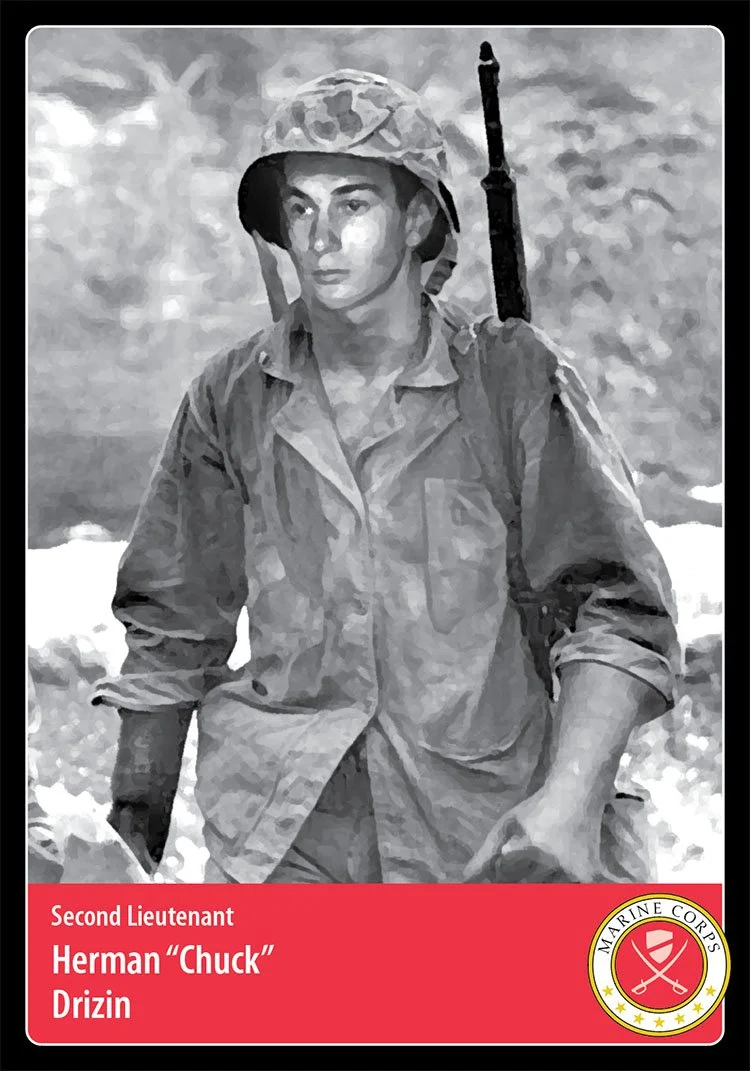Hero Card 54, Card Pack 5
Artist’s rendering by Craig Du Mez
Hometown: Philadelphia, PA
Branch: U.S. Marine Corps
Unit: E Company, 2nd Battalion, 23rd Marines, 4th Marine Division
Military Honors: Purple Heart
Date of Sacrifice: March 6, 1945 - KIA on Iwo Jima, Japan
Age: 24
Conflict: World War II, 1939-1945
Herman “Chuck” Drizin grew up in Philadelphia, Pennsylvania, where he attended Villanova University from 1940-1943. Drizin became a star basketball player for the Wildcats, leading the team to a 19-2 record in the ’42-’43 season—the highest winning percentage in the university’s history, and a record that held for 72 years.
According to Drizin’s nephew, in an interview with a former teammate, Herman Drizin was described as “a 6'2" sharpshooter who could do it all and who was a sure bet to make the fledgling NBA.”
After joining the military during World War II, Second Lieutenant Herman Drizin was part of the first wave of Marines to land on the Japanese island of Iwo Jima in February of 1945.
Known to American soldiers as the “Pork Chop” because of its shape, Iwo Jima is a small volcanic island 750 miles south of Tokyo, Japan. With an air base that could serve as a springboard to an invasion of the Japanese home islands, Iwo Jima was strategically important to both Imperial Japan and the American military.
When U.S. Marines invaded the island on February 19, 1945, they encountered some 18,000 Japanese soldiers who had carved out an extensive network of caves, tunnels, and underground bunkers. The Japanese soldiers refused to surrender or be taken prisoner. For the U.S., taking Iwo Jima required them to brave heavy fire on the beaches and intense close-quarter assaults on the underground strongholds.
On February 28, 1945, Lt. Drizin led an attacking platoon in the early stages of the battle, penetrating deep into Japanese defenses east of Iwo Jima’s sulfur pits. In an account from The Philadelphia Inquirer:
“[Lt. Drizin] led his squad of 13 men who, cut off from their unit, advanced a quarter of a mile into enemy lines, knocked out three [Japanese] tanks, killed a dozen Japanese and suffered only one casualty. A Marine Corps combat correspondent describing the gallant attack, said Drizin’s men dodged from hill to hole, hiding behind blasted tree stumps and rock piles, and had to face not only Japanese fire but also bombing, strafing and rockets coming from American planes, which could not know that the small group 300 yards ahead of the front lines was a Marine patrol.”
Less than a week later, on March 6, Lt. Drizin lost his life on Iwo Jima.
While ultimately victorious after 36 days of brutal fighting, the Americans suffered nearly 7,000 killed and more than 19,000 wounded—by far the highest single-action losses in Marine Corps history. Including those killed in Naval bombardments preceding the invasion, the Japanese lost approximately 22,000 soldiers and sailors.
Today, the victory at Iwo Jima is remembered for the flag-raising on Mount Suribachi, captured in Joe Rosenthal’s Pulitzer Prize-winning photo.
Lt. Herman Drizin is honored by Villanova University, with an annual “Chuck Drizin Award,” given to a graduating athlete who demonstrates dedication, loyalty, and unsung heroism. Drizin is also remembered by the Jewish War Veterans organization, which named their Drizin-Weiss Post. No. 215 in Philadelphia in his honor.
Sources
Artist’s rendering: Craig Du Mez
Details submitted by Michael Brown, Villanova University
Villanova.edu: Honoring the Fallen—Herman Drizin
Huffpost.com: The Blog—Jewish War Veteran’s Uncommon Valor in Life Is More Important Than His Valor in Death
The Philadelphia Inquirer: Lieut. Drizin Killed on Iwo; Former Villanova Athlete
The National WWII Museum: Iwo Jima and Okinawa: Death at Japan’s Doorstep
The National WWII Museum: The Battle for Iwo Jima (Fact Sheet)
National Park Service—Marine Corps History and Museum Division: Iwo Jima’s Costs, Gains, and Legacies
Burial Site: Find a Grave





